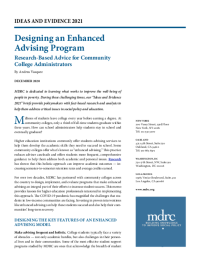Designing an Enhanced Advising Program
Research-Based Advice for Community College Administrators

MDRC is dedicated to learning what works to improve the well-being of people in poverty. During these challenging times, our “Ideas and Evidence 2021” briefs provide policymakers with fact-based research and analysis to help them address critical issues in social policy and education.
Millions of students leave college every year before earning a degree. At community colleges, only a third of full-time students graduate within three years. How can school administrators help students stay in school and eventually graduate?
Higher education institutions commonly offer students advising services to help them develop the academic skills they need to succeed in school. Some community colleges offer what’s known as “enhanced advising.” This practice reduces adviser caseloads and offers students more frequent, comprehensive guidance to help them address both academic and personal issues. Research has shown that this holistic approach can improve academic outcomes — increasing semester-to-semester retention rates and average credits earned.
For over two decades, MDRC has partnered with community colleges across the country to design, implement, and evaluate programs that make enhanced advising an integral part of their efforts to increase student success. This memo provides lessons for higher education professionals interested in implementing this approach. The COVID-19 pandemic has magnified the challenges that students in low-income communities are facing. Investing in proven interventions like enhanced advising can help these students succeed and also help their communities’ long-term recovery.
Designing the Key Features of an Enhanced Advising Model
Make advising frequent and holistic. College students typically face a variety of obstacles — not only academic hurdles, but also challenges in their personal lives and in their communities. Some of the most effective student support programs studied by MDRC are ones that acknowledge the breadth of student needs. Holistic advising is a key component of the City University of New York’s Accelerated Study in Associate Programs (CUNY ASAP), which provides an array of academic, personal, and financial supports to students. MDRC’s evaluation of CUNY ASAP found that in addition to helping students get acclimated to college, choose classes, and pick a major, ASAP advisers helped them develop soft skills such as study habits and time management; balance home, work, and school demands; and participate in extracurricular activities and campus life.
Create small caseloads. Smaller caseloads make it possible for advisers to meet regularly and more often with students and to build trust. Over time, advisers and students get to know one another and develop a relationship that may open the door to discussing a wider range of topics. Institutions should hire enough advising staff members to keep caseloads small.
Provide proactive outreach, even when students are unresponsive. Students from low-income households who could benefit the most from these programs are often the hardest to reach. They are more likely to face competing responsibilities outside of school and have greater limits on their time and availability. Active, frequent, and varied outreach can be an effective way to increase their engagement. Keeping unresponsive students on advisers’ caseloads requires additional resources but doing so can benefit students with the highest level of need.
Offer students incentives to meet with their advisers. Cash rewards, book vouchers, and transportation benefits can increase student participation. For instance, the community colleges in MDRC’s SUCCESS program provide $50 monthly incentives to students who meet with their advisers twice a month. Surveys and focus groups showed the incentives piqued students’ interest in the program and helped them cover the cost of things like books and food.
Provide enhanced advising services for as many semesters as possible. Extending enhanced advising services over multiple semesters can amplify their impact. To mitigate some of the costs of doing so, programs can lower engagement expectations in later semesters as some students begin to show signs of success. In the ASAP Ohio Demonstration, students were required to meet with their advisers twice a month during their first semester in the program. In the second semester and extending through the end of the three-year program, advisers “triaged” students, sorting them into low-, medium-, and high-need groups. Those in the high-need group were required to continue meeting with their advisers twice a month, while the rest of the students were generally expected to meet at least once a month.
Structuring the Team
Hire full-time advisers. Full-time employment status can confer respect on the team and strengthen advisors’ connections with offices offering campus resources. Part-time staff members can certainly provide advising assistance. However, they often have less time and less flexibility to meet with students and may have weaker connections to campus resources. They may also be more likely to leave their jobs for positions with better pay and benefits.
Hire advisers that students can relate to. Students may have an easier time connecting with advisers who share their background and can empathize with their lives and challenges. Students may be more comfortable asking for support if they feel they are accepted and belong.
Using Data to Continually Improve the Program
Encourage and empower advisers to use data. Institutions should invest in a data tracking or management information system that will allow advisers to easily record, share, and analyze student engagement data and metrics relevant to the goals of their program. Data use is central to the coaching strategy in Detroit Promise Path — a program that provides support services and a scholarship to offset costs not covered by financial aid. By reviewing data daily, coaches are able to see which students they have not met with and then do targeted outreach. This has helped increase the number of students attending coaching sessions.
Advising staff members can also use data to build an outreach strategy that focuses on the students with the highest level of need and allows them to share information about student progress with other advising staff and to assess the effectiveness of different strategies. Advising coordinators can use this data to monitor advisers’ progress and provide better feedback and support.
Give advisers access to institutional data. Institutional databases with information on students’ academic profiles can be another powerful tool for advising staff members. The ability to easily access information such as student grades and class schedules can help advisers personalize student support. However, the employment status of staff (full time versus part time) may determine the level of data that an institution will make available to them.
Use program engagement data to examine opportunities for improvement. Engagement data can help paint a clear picture of how well a program is performing. Encourage the coordinator and advisers to meet on a regular basis to review this data and consider how to make the most of it. Convene teams of advisers, coordinators, and other program stakeholders to review the data and discuss the program’s goals. This can encourage everyone to take ownership of program improvement, rather than leaving data analysis to a narrower group. Summer months are a good time to do this, when advisers typically have fewer students to serve.
Planning for Your Program to Grow
Create activities for groups of students. The number of students that the program reaches may grow faster than the size of the advising team. One way to help advising staff members increase capacity without sacrificing the quality of advising is by engaging students in group activities that complement or partially replace one-on-one meetings. Although the long-term goal is to reduce caseload size, this interim step can help staff temporarily manage more students. Bringing groups together can have the added benefit of fostering a sense of community and belonging.
If connecting with students virtually, consider who might be left out. Using video or phone calls instead of (or in addition to) in-person meetings can help advising teams reach more students, eliminating the need for them to commute to and from campus. However, these methods may not work well for everyone. As the COVID-19 pandemic has revealed, some students may lack access to reliable internet connections, the necessary devices, and private spaces in which to have sensitive conversations. Advising staff members should consider these factors when creating a virtual communications plan.
Students are facing many personal and academic challenges in the wake of the pandemic. Enhanced advising programs can help support students as they navigate these challenges — and ultimately help them succeed in school and make progress toward earning a degree. Designing and implementing a successful enhanced advising program requires a significant level of investment. The recommendations in this memo can help policymakers and other stake-holders make more resources available to colleges, and guide practitioners in their work to employ best practices.
This memo is adapted from “How to Design and Implement Advising Services in Community Colleges: Lessons from Two Decades of Research and Technical Assistance,” a policy brief written by MDRC with generous support from the Bill & Melinda Gates Foundation. Please see the full brief for additional tips and tools to bolster advising services.






